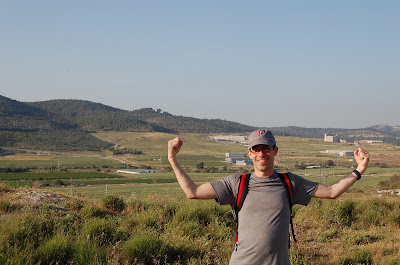After that, we had a free afternoon in Jerusalem. We spent our time eating Pizza (yum!), shopping for souvenirs, getting lost, and getting to things after they had closed or were to crowded for us to go in. It turns out, having a guide lead us around most of the time is quite helpful (thank you Todd!) We spent the last hour of our time sitting in the shade reading, resting and calling home. Then we got to spend a very relaxing evening at our guest house up on the mountains surrounding Jerusalem and truly got to have a Sabbath to rest and recover from a busy week!

Walking around the Biblical garden on the property of the Yad Hashmona Guest House.

Baby grapes!
The next morning we left the Jerusalem area and headed north to Caesarea - an ancient port city that Herod the Great built to connect with Rome.

A view of the ruins at Caesarea - quite a large city in the 1st century.

We also got to see (and touch) the Mediterranean Sea!

Matt was excited to get to stand in the rooms of the Herod's Palace where Paul would have been imprisoned in Caesarea (Acs 23-25).

We stopped a little ways north of Caesarea to see the remains of a massive aqueduct system that Herod built to bring fresh water to Caesarea from the springs of Mt. Carmel.

We then drove up to the top of Mt. Carmel and climbed to the roof of a monastery up there to overlook the Jezreel Valley. Above is a statue of Elijah in the courtyard of the monastery.

While looking at the Jezreel Valley below, we read the story of Elijah from 1 Kings 17-18 where he challenges the prophets of Baal to call on Baal to send down fire to light their sacrifice. After calling on Baal all day but got no answer. Then Elijah took his sacrifice and poured fur jars of water on the offering and the wood... three separate times! The he called on the name of the LORD and the fire of the LORD came down and burned up the sacrifice, the wood, the stones of the altar, and the soil.

While driving down the road, we pulled over to take pictures of a 1st century tomb that was discovered while making the road. This tomb has a rolling stone next to it similar to what would have been in front of Jesus's tomb.

We then went on to the Tel of Megiddo - which was an ancient city on the southern edge of the Jezreel valley. Referenced here was Revelation 16:16 which names this valley as the staging ground for battle - Armageddon, "Mountain of Megiddo."

We then stopped at Ein Herod (spring of Harod) where Gideon trimmed his army down to 300 men before going in to battle so that the victory was truly God's (Joshua 7). It was so amazing to be standing at the site where this historic event took place!

Matt and I in front of a bougainvillea plant like we had in our back yard in Phoenix - good memories of it's beauty, but bad memories of it's thorns!

Next we went to Tel Jezreel and talked about a number of stories from 1st and 2nd Kings that took place here. One was from 1 Kings 22 when Ahab & Jehoshaphat fought the Arameans. We also read about King Jehu from 2 Kings 9 where he has success in battle against the town of Jezreel.
We ended the day by driving up the mountains into Jesus's home town of Nazareth. We were tricked by our leader into believing that our hotel was kind of a run down one, but as we pulled out were pleasantly surprised to find we were staying in the nicest hotel of the trip. The luxury Golden Crown hotel on the outskirts of Nazareth. It was a very nice treat and a relaxing night. We got to Skype with our kids and my family who was staying with them and it was great to see everyone's faces. Only a few more days on the ground here until we head home. We are tired and mentally full but still loving our time in the land of Israel!







































